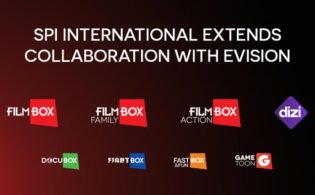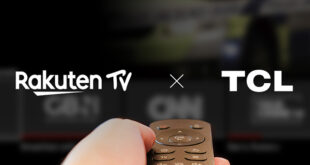As chief marketing and digital officer at SPI International, a CANAL+ company, Haymi Behar has been at the forefront of the evolution of the TV landscape, harnessing the combination of linear and digital. The company has responded to the fast-changing ecosystem with the launch of Smart Channels on its FilmBox+ streaming service, with specially curated playlists of on-demand content that play back-to-back similar to traditional linear channels. Behar tells World Screen about the lean-back and lean-forward approaches to viewing.
WS: How has the TV experience evolved, with the combination of linear and digital?
BEHAR: I believe the future of the TV experience will be a hybrid; it will be a combination of a vast VOD selection with a lot of verticals and genres as well as linear. Linear has two major advantages. One is live TV, and the second is the channel surfing experience. The channel surfing experience creates a unique discoverability option for content. People do the curation for you, so you can serendipitously move between different channels based on the content you like to watch. I think the lean-back approach, which is the live TV approach, will always live with us, mainly because of news and live sports events, as well as new types of channels such as FAST channels and the Smart Channels that SPI has introduced with FilmBox+.
WS: Where does FAST fit in to this evolution?
BEHAR: When you look at all the streamers, the biggest platforms in the world are the ones that are monetizing with advertising. The ad dollars are very important because they come from the TV world, which is very clearly measurable based on ROI—even though it’s based on a sample, it’s very well established. So, the marketers know which target group they’re targeting, exactly where the money is spent and how many people they reach. This is why I think the future of TV and digital streaming is moving toward grabbing more of those ad dollars. That’s where FAST channels and AVOD are coming in for the streamers as well.
WS: Walk me through SPI’s FAST offerings.
BEHAR: We have Filmstream, which has been broadcasting for three years on multiple platforms worldwide. It’s an arthouse movie channel that’s localized in multiple languages and available on Samsung TVs and with other operators in the U.K., Australia, the U.S. and a lot of territories. We also have Dramastream, which is a series channel, and Docustream, which is a documentary FAST channel. Fashionstream, which is for fashion content, is available in Latin America. We’re doing FAST in multiple countries with platforms like Pluto TV and many others.
WS: Tell me about SPI’s latest innovation, Smart Channels, which are exclusive to the FilmBox+ platform.
BEHAR: Smart Channels are an innovative way of offering our content to our viewers and operators. They have already launched in millions of homes globally, as well as across SPI’s core territories such as Europe, the Adriatic region, Bulgaria, Hungary, Romania and Turkey, with channel availability varying by territory. We have around 200 Smart Channels, which are digitally curated streaming channels that are deployed through our content management system. You can think of it like a playlist on a music streaming app. SPI has around 14,000 pieces of content in its library. It would be an incredible waste of time for a consumer to go through all of this content in order to find something to watch. So, we categorize and recommend content, but we also wanted to tap into the lean-back approach. FilmBox+, which is integrated already with around 50 operators across Europe, is offering linear channels as well as VOD content together in a hybrid model that you can subscribe to directly or through the subscription that you have with your operators. The app is integrated with operators’ apps and smart TVs. You can use the login with your operator and download our app to your iPhone or iPad and then log into our app as well. We also wanted to offer people the option to discover content in a different way, which is the linear channels. We already have satellite linear channels within our app, and we see that the viewership is very high on those channels from within the mobile app as well. So we said, why don’t we create—for smart TVs, mobiles, tablets, laptops—a product that’s within our FilmBox+ app that makes content discoverability much easier. We decided to create some genre-specific channels. Our editors sit down and pro- gram, let’s say kids’ content, with 100 hours of programming at minimum, put them together, and then it’s launched with a special logo and brand name. In every country that we’re in, we have at least 25 or 30 channels, including the Smart Channels. This is a great way of discovering content. We launched this at the beginning of 2023, and we see that the viewership is going up. Almost 20 percent of our app viewership is now coming from Smart Channels. People are reacting really positively.
WS: There’s talk about “choice fatigue” and the need to maximize discoverability of existing content through customization. How do these Smart Channels help, essentially, do more with less?
BEHAR: Every decision we make is based on data. When we were doing some marketing research in Netherlands, where we have our flagship Film1 app, we realized that people are experiencing choice fatigue. When people go home, put the kids to bed or eat something and are tired from work, they have maybe an hour or two during the evening to watch something and entertain themselves. Every day, we are facing thousands of choices. When it comes to entertainment, we actually prefer that somebody makes those choices for us. This is where curation comes in, and this is where choice fatigue takes its toll. Our research shows that almost 50 percent of the viewers in the Netherlands in 2022, once they could not find something to watch, they gave up completely (women more so than men). They end up spending half an hour (a quarter or a third of the time that they have for the evening to watch something) searching for something. When we established that choice fatigue is a real issue, we started to promote our linear channels more because they’re curated and professionally designed to allow people to just enjoy the content. Once you are in our apps, browsing through the channels and stumble upon a movie or show that you like, maybe it’s in the middle of it, you can always just press a button to watch it from the beginning within the app. Browsing through the EPG, you can see what’s coming next. It’s a combined experience of lean-back and lean-forward approaches, linear channel and VOD—a “press and play” that tries to offer more choice to the viewer so that they can just focus on enjoying the content rather than trying to make another choice.
WS: Talk to me about curation. How is quality curation key for better content proposition?
BEHAR: Curation is almost everything. Programmers in the traditional TV world have a lot of experience. When you leave the curation to machines, the algorithms will always show you something that is based on your past. If you watch a couple of romantic comedies, you’ll end up seeing a lot of suggestions of the same sort. It doesn’t mean that on that specific date you are in that mood; maybe you want to watch a sports documentary or a thriller, a crime series or a classic movie in a different language. The recommendation engines offer you [options] based on your past experiences, so it keeps coming back to your past, which may not be holding true for the current day. This is why curation is so important. Curation is based on data of viewers’ choices and also on certain occasions. If it’s Christmas time, you should create more offers with Christmas movies. Seasonality is important, and current events are important. If there’s a war going on between certain countries, people tend to look for more war or political documentaries. Consuming content is about entertaining ourselves, but it is also educational experience. If it’s a Sunday morning on a regular TV channel, you would expect to see a family movie or some sort of kids’ content that you can enjoy as a family. Curation is key, and it [is backed by over] 50 years of TV building experience. As a traditional broadcaster of pay TV around the world, SPI is now applying this know-how to our digital apps and offering it through operators. We are seeing great results. The operators that we work with in countries like Romania, Poland, the Czech Republic, the Netherlands, Bulgaria and Turkey are all giving us positive feedback and data [showing that] the well-curated content is doubling or tripling their app usage. Based on that experience, we’re also creating and offering them more content based on seasonality.
WS: With these Smart Channels, and FAST Channels, what are your projections for AVOD as we look ahead?
BEHAR: The future will be a combination of AVOD and SVOD. We are already starting to see this happening with certain streaming platforms. At FilmBox+, we are also building our AVOD offer and hopefully will be launching it before the end of this year. We are already doing live testing of the AVOD option.
What is coming up is the fact that ad dollars are going to linear TV and AVOD-based streaming platforms such as YouTube worldwide. It’s a very important monetization tool that we cannot disregard. Young generations not interested in paying as much to streamers, they opt for AVOD. People, in general, actually don’t mind seeing some ads before watching content either if they’re going to pay less or pay nothing to watch the content or if the ad is somewhat relevant to that. That’s where the challenge for FAST channels is. FAST platforms are not yet able to supply the data that is necessary for the advertisers to spend more. In a typical ad-marketer’s mind, 70 percent of their budget will be spent on traditional means where they are sure that the return on investment is guaranteed. This could be digital advertising, out-of-home or traditional TV, depending on the needs of the product their marketing. Around 20 percent will go to newer methods of advertising, such as influencers, Twitch, blogs, Reddit, etc., depending on the country. Then, 10 percent will go to the completely experimental new media. For a media company or media product to be successful, they have to supply the right data and the right targeting for the advertiser. FASTs have not yet demonstrated their effectiveness as a viable platform for maximizing advertising investments and deriving significant benefits from that major part of the budget. FAST channels have yet to reach that point. This is where streaming services such as FilmBox+ hold an advantage. We know who our subscribers are, and we know what they are watching. We don’t have to supply this data to the advertisers, but we can create clusters of target groups so the advertisers will reach the audience they want in a legal and accepted way.
WS: With an eye to this evolution we’ve been talking about, what do you see as the impact of AI in content creation and viewing habits?
BEHAR: At the end of the day, we are all in the storytelling business. What AI is doing so far with generative AI is cracking the code of the human race, which is language. Through language we learn, live, fight, love and communicate. What AI does is actually create content and use language, which is the human code of communication. Current AI could be potentially dangerous, but at the same time, it is a huge tool for content creation, video generation, graphic design, storytelling, story creation, dubbing and helping with coding. If you use it in the right way, it’s like you have an entire team helping you and working with you. It holds huge potential to speed up content creation efforts, content distribution efforts, app building efforts. Mixing it with your own human creativity, you can refine it, improve it and use it. Ultimately, it saves marketers and content creators valuable time while stimulating their thinking process.






